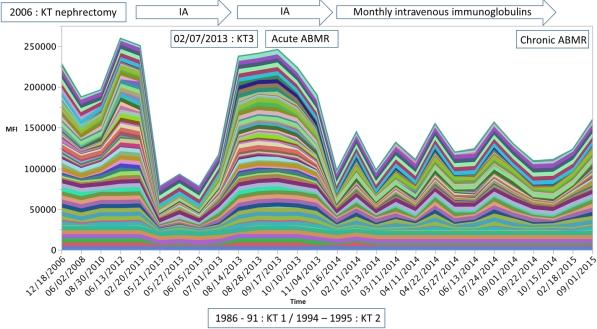Immuoadsorption-Based Desensitization in Highly Sensitized Patients Awaiting Deceased Donor Kidney Transplantation.
Urgences Néphrologiques et Transplantation Rénale, Tenon Hospital, APHP, Paris, France.
Meeting: 2018 American Transplant Congress
Abstract number: A152
Keywords: Alloantibodies, Highly-sensitized, Immunoadsorption, Kidney transplantation
Session Information
Session Name: Poster Session A: Kidney Immunosuppression: Desensitization
Session Type: Poster Session
Date: Saturday, June 2, 2018
Session Time: 5:30pm-7:30pm
 Presentation Time: 5:30pm-7:30pm
Presentation Time: 5:30pm-7:30pm
Location: Hall 4EF
An estimated 30% of patients on the waiting list are deemed highly sensitized due to preexisting anti-HLA antibodies often irrevocably precluding kidney transplantation (KT). Immunoadsorption (IA) a chromatographic technique designed to purge patient antibodies has emerged as a mean to overcome this immunological barrier. Whether IA as part of desensitization protocols may facilitate deceased donor KT remains to be proven.
A retrospective study was conducted in the transplantation department of Tenon Hospital in Paris between 2012 and 2017 to assess the impact of IA on the KT waiting time, one year kidney graft function, acute and chronic antibody-mediated rejection (ABMR) and infectious complications. Kinetics of HLA antibodies and donor specific antibodies evaluated through the Luminex® technique were examined for each patient based on a graphical depiction of the cumulative mean fluorescence index. Immunosuppression was commenced upon initiation of IA and consisted of steroids, tacrolimus 0.2 mg/kg and mycophenolate mofetil 2 g daily. During 2 weeks, IA was performed for 5 consecutive days, than thrice weekly for 2 weeks and finally 3 monthly sessions of IA were performed prior to KT.
Fifteen patients underwent IA-based desensitization. Fourteen patients were transplanted after 20 IA sessions [14.5-65]. Median age was 45 years [40 – 60]. Seven patients had prior KT.Wait time before IA was 6 years [range 5 – 7] and the interval between IA initiation and KT was 3.75 months [1.1 – 1.6](p<0.001). Out of 8 patients with a minimum of one year follow-up, 7 developed acute ABMR and one chronic ABMR. There was one graft loss and median plasma creatinine level was 130 [micro]mol/L [113 – 173]. Three patients developed life threatening infections.
Fig. 1 Time course of anti-HLAs antibodies for one patient of the study.
These results suggest that IA-based desensitization enables to expedite KT in patient with otherwise very restricted access with an acceptable one-year outcome, at the expense of a high rate of ABMR and severe infectious complications. Long term follow-up on large size cohorts is required.
CITATION INFORMATION: Bureau C., Galichon P., Luque Y., Ouali N., Rondeau E., Rafat C. Immuoadsorption-Based Desensitization in Highly Sensitized Patients Awaiting Deceased Donor Kidney Transplantation. Am J Transplant. 2017;17 (suppl 3).
To cite this abstract in AMA style:
Bureau C, Galichon P, Luque Y, Ouali N, Rondeau E, Rafat C. Immuoadsorption-Based Desensitization in Highly Sensitized Patients Awaiting Deceased Donor Kidney Transplantation. [abstract]. https://atcmeetingabstracts.com/abstract/immuoadsorption-based-desensitization-in-highly-sensitized-patients-awaiting-deceased-donor-kidney-transplantation/. Accessed December 20, 2025.« Back to 2018 American Transplant Congress

